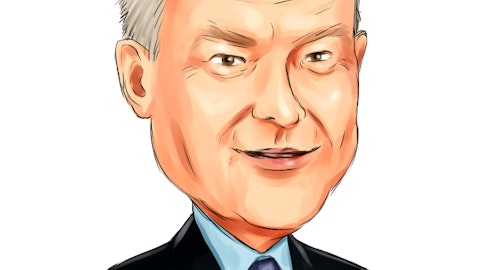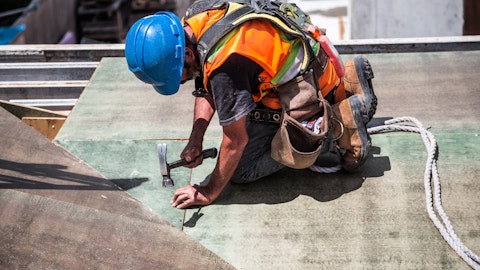M/I Homes, Inc. (NYSE:MHO) Q4 2022 Earnings Call Transcript February 1, 2023
Operator: Good afternoon, ladies and gentlemen. Thank you for joining today’s M/I Homes’ Fourth Quarter and Year Ending Earnings Conference Call. My name is Tia, and I will be your moderator for today’s call. All lines will be muted during the presentation portion of the call with an opportunity for questions and answers at the end. . I would now like to pass the call over to our host, Phil Creek with M/I Homes. Please proceed.
Phil Creek: Thank you. And thanks for joining us today on the call. In Columbus is Bob Schottenstein, our CEO and President; Susan Krohne, our SVP and Chief Legal Officer; Derek Klutch, President of our Mortgage Company; Ann Marie Hunker, VP, Chief Accounting Officer and Controller; and Mark Kirkendall, VP and Treasurer. First, to address Regulation Fair Disclosure, we encourage you to ask any questions regarding issues that you consider material during this call because we are prohibited from discussing significant non-public items with you directly. And as to forward-looking statements, I want to remind everyone that the cautionary language about forward-looking statements contained in today’s press release also applies to any comments made during this call. Also be advised that the company undertakes no obligation to update any forward-looking statements made during that call. With that, I’ll turn the call over to Bob.
Bob Schottenstein: Thanks, Phil. Good afternoon, and thank you for joining our call. We are pleased to report our fourth quarter and full year 2022 results highlighted by record revenue, record income and very strong returns. We increased our revenue by 10% to a record $4.1 billion, increased pre-tax income by 25% to a record $635 million and improved our operating margin by 160 basis points to 15.4%. In addition, we ended the year in the best financial condition in our 46-year history with the cash balance over $300 million, zero borrowings under our $650 million credit facility, and a debt to capital ratio of 25%. We were particularly pleased to deliver such strong operating and financial results in the face of challenging market conditions.
As has been well documented, the rapid rise in interest rates over the past nine months has materially impacted demand for new homes and demand for existing homes. On the other hand, the demand for homes has not vanished. Instead, the higher rates have resulted in potential buyers taking a pause and moving to the sidelines. There remains very tangible homebuyer demographics, particularly among millennials and Gen Z individuals, and the prolonged undersupply of homes that has persisted for years, all gives us great confidence in the long-term outlook for the housing market and our industry. Our new contracts for the full year 2022 decreased by 27% compared to the record sales we posted in 2021. For the fourth quarter, our new contracts were down 44% compared to a year ago.
However, as Phil will outline in a few minutes, we saw our sales and demand begin to improve during the latter part of the fourth quarter despite the higher rate environment. Moreover, and importantly, the improvement and strength in buyer demand, traffic and sales has continued into 2023. Specifically, with noticeably stronger levels of traffic both in our models and online, we sold 633 homes in January. This is our best sales month since April of last year. And though down 18% from a year ago, this represents an approximate 60% sequential improvement over the average monthly sales we recorded during the last half of 2022. Clearly, we are encouraged by this recent material improvement in our traffic and sales and similar commentary from select other builders adds to this encouragement.
While there remains much uncertainty in the market and no one really knows whether this recent strengthening and improvement in demand and sales will continue, we do believe it underscores and confirms the underlying homebuyer demographics and desire for a new home. Now I’d like to provide some comments on our specific markets. We experienced strong performance from our divisions in 2022 with substantial income contributions across the board, led by Dallas, Tampa, Columbus, Orlando, Raleigh and Charlotte. In our Southern region, which consists of 11 markets in Texas, Florida, North Carolina and Tennessee, our deliveries increased 4% over last year’s fourth quarter, comprising 1,413 deliveries, or 59% of the total. Northern region, which consists of our other six markets located in Ohio, Indiana, Illinois, Michigan, and Minnesota, contributed 971 deliveries, which was an increase of 2% over last year’s fourth quarter.
For the year, homes delivered decreased 5% in the Southern region and were flat in the Northern region. Our fourth quarter new contracts in the Southern region decreased by 41% and decreased by 48% in the Northern region. For the year, new contracts decreased 28% in the Southern region, 25% in the Northern region. Our owned and controlled lot position in the Southern region decreased by 8% compared to a year ago and increased by 3% in the Northern region when compared to 2021. Companywide, we now own approximately 25,000 single family lots or lot equivalents. Of this total, 32% are in the Northern region, 68% in the Southern region. This equates to roughly a three-year supply of owned lots. On top of the own lots, we control pursuant to option contracts, an additional 17,100 lots.
So in total, we own and control roughly 42,000 single family lots, which is down 4% from a year ago and equates to about a five-year supply. Most importantly, about 41% of our lots are controlled under option contracts, thereby giving us significant and important flexibility to react to changes in market conditions. Before I turn the call over to Phil, let me just close with a few additional comments. We are very excited about our business as we look ahead to 2023. The new communities that we opened in 2022 are performing well. And the planned new community openings for 2023 should further contribute to the strength of our operation. Building upon the long-term success of our Orlando, Tampa and Sarasota operations, we recently announced our entry into the Fort Myers/Naples market.
This will allow us to continue our growth along the southwest coast of Florida. As I mentioned at the beginning of my remarks, our financial condition is excellent, as strong as it’s ever been, with low debt levels, significant cash and a well balanced land position. The operating strategy we have employed is very well suited to respond to current macroeconomic conditions. For all these reasons, we believe M/I Homes is very well positioned for 2023 and beyond. With that, I’ll turn the call over to Phil.
Phil Creek: Thanks, Bob. Our new contracts were down 45% in October, down 51% in November and down 35% in December for a 44% decline in the quarter compared to last year’s fourth quarter. And our sales pace was 1.8 in the fourth quarter compared to 3.3 in last year’s fourth quarter. And our cancelation rate for the quarter was 30%. As to our buyer profile, about 58% of our fourth quarter sales were to first-time buyers compared to 53% a year ago, and 64% of our fourth quarter sales were inventory homes compared to 45% in last year’s fourth quarter. Our community count was 196 at the end of 2022 compared to 175 a year ago. During the quarter, we opened 25 new communities while closing seven. For the year, we opened 101 new communities compared to opening 72 in 2021.
We currently estimate we will end 2023 with about 225 communities. We delivered an all-time quarterly record 2,384 homes in the fourth quarter, delivering 53% of our backlog compared to 43% a year ago. And revenue increased 16% in the fourth quarter of this year, reaching an all-time quarterly record 1.2 billion. Our average closing price for the fourth quarter was 492,000, an 11% increase when compared to last year’s fourth quarter average closing price of 443,000. And our backlog average sale price is 541,000, up 11% from a year ago. In the fourth quarter, we recorded a pre-tax charge of 18.4 million for impairments, or $0.50 per diluted share. This charge consisted of 10.2 million of pre- acquisition land costs and 8.2 million of inventory valuation charges.

Our gross margin, exclusive of the impairment charge, was 24.1 for the quarter, up 90 basis points year-over-year. And for the full year, our gross margins improved 140 basis points to 25.7, exclusive of the impairment charge. Our fourth quarter and full year SG&A expenses as a percent of revenue were 9.1% and 9.8% of revenue, a 70 and 60 basis point improvement compared to the prior year, reflecting greater operating leverage and our lowest percentage ever. We constantly review our cost structure and due primarily to our lower year-end backlog, we reduced our headcount by 8% in January of 2023. Interest expense decreased 400,000 for the quarter and increased slightly for the year. Interest incurred for the quarter was 9.2 million compared to 9.4 million a year ago.
And for the year, interest incurred was 38 million versus 39 million last year. We are pleased with our improved returns for the year. Our pre-tax income was 15.4% versus 13.6% last year, and our return on equity remained a strong 27%. During the fourth quarter, we generated 196 million of EBITDA compared to 155 million in last year’s fourth quarter. And for the full year 2022, we generated 705 million of EBITDA, up 24% over the prior year. We generated 184 million of cash flow from operations in 2022 compared to using 17 million in 2021. Our effective tax rate was 21% in the fourth quarter compared to 20% in last year’s fourth quarter. Our annual effective rate for 2022 was 23% compared to 22% the year before. We expect 2023’s effective tax rate to be around 24%.
Our earnings per diluted share for the quarter increased 21% to $4.65 per share from $3.83 per share in last year’s fourth quarter and increased 30% for the year to $17.24 per share from $13.28 per share last year. During 2022, we repurchased 1.2 million of our outstanding common shares for 55 million, leaving 93 million available under our current repurchase authorization. We did not repurchase any shares in the fourth quarter. Now Derek Klutch will address our mortgage company results.
Derek Klutch: Thanks, Phil. In the fourth quarter, our mortgage and title operations achieved pre-tax income of $9.7 million, down $1.1 million from 2021 and revenue of $22.6 million, down 1% over last year. It was primarily a result of lower pricing margins and fewer loans closed and sold. For the year, pre-tax income was $39.3 million and revenue was $86.2 million. Loan to value on our first mortgages for the quarter was 82%, the same as 2021’s fourth quarter. 79% of the loans closed in the fourth quarter were conventional and 21% were FHA or VA compared to 81% and 19%, respectively, for 2021’s same period. Our average mortgage amount increased to $392,000 in 2022’s fourth quarter compared to $360,000 in 2021. Loans originated in the quarter decreased 12% from 1,692 to 1,497, and the volume of loans sold decreased by 4%.
Our borrower profile remains solid, with an average down payment of over 18%. And for the quarter, the average borrower credit score on mortgages originated by M/I Financial was 7.46. Our mortgage operation captured 77% of our business in the quarter, a decrease from 83% in 2021’s fourth quarter. Finally, we maintain two separate mortgage warehouse facilities that provide us with funding for our mortgage originations prior to the sale to investors. At December 31, we had a total of 246 million outstanding under these facilities, which expire in May and October this year. Both facilities are typical 364-day mortgage warehouse lines that we extend annually. Now I’ll turn the call back over to Phil.
Phil Creek: Thanks, Derek. As far as the balance sheet, we ended the fourth quarter with no borrowings under our unsecured revolving credit facility. Our total homebuilding inventory at year end was 2.8 billion, an increase of 400 million above prior levels. And we had 4,700 homes under construction at year end, which includes our backlog and inventory homes. That is down 12% from 12/31/21’s 5,300 houses. During 2022, we spent 341 million on land purchases and 496 million on land development for a total land spend of 837 million. This was down from 1.1 billion in 2021. In 2022, we purchased 8,000 lots compared to 2021’s 17,000 lots. At 12/31/22, we had 625 million of raw land and land under development and 684 million of finished unsold lots.
We own 8,500 unsold finished lots with an average cost of 80,000 per lot, and this average lot cost is 15% of our 541,000 backlog average sale price. And at the end of the year, we had 485 completed inventory homes and 1,827 total inventory homes. Of the total inventory, 890 are in the North region and 937 are in the Southern region. And at 12/31/21, we had 99 completed inventory homes and 1,266 total inventory homes. This completes our presentation. We will now open the call for any questions or comments.
See also 12 Cheap Blue Chip Stocks To Buy and 12 Best S&P 500 Dividend Stocks To Buy.
Q&A Session
Follow M/I Homes Inc. (NYSE:MHO)
Follow M/I Homes Inc. (NYSE:MHO)
Operator: We will now begin the Q&A session. . The first question comes from the line of Jesse Lederman with Zelman & Associates. Please proceed.
Jesse Lederman: Hi. Thanks for taking my questions and congrats on the strong results. And I appreciate all the color you provided in your prepared remarks.
Bob Schottenstein: Thanks, Jesse.
Jesse Lederman: My first question pertains to the pricing side of the equation. You gave some good color on demand thus far into January and the step up from December. Can you talk a little bit about how your pricing philosophy is reacting to that demand, or is the demand surging relative to December because of the pricing initiative you’ve taken? In other words, has pricing firmed up at all?
Bob Schottenstein: First of all, I think there’s no one thing. I think it’s a combination of a number of things. I do think that there could be some group of buyers that are beginning to settle in with rates now hovering in that low to mid 6s. Having said that, we have aggressively tried to generate traffic by selectively promoting bought-down interest rates not in every community or in every market but in enough divisions that we can headline advertise it on our Web site. That has helped draw traffic and gotten people into the models. We do expect our margins to come down this year. We’ve historically said that this is a 21%, 22% business. And, of course, we were running at 25% or 26% across the board for quite some time. This is strictly intuition.
It feels like things might be leveling off somewhat. Every market is different. There appears to be more strength in certain of the Texas and Florida and Carolina markets than perhaps in some of the others. But as I said in my comments, even though four weeks does not a season make, it is a strong start to the year. We had averaged during the last six months of last year, you can do the math, about 390 sales a month from July through December. And we sold 633 in January. And some of our Midwestern markets posted very strong sales. And we saw a noticeable uptick in traffic, both Web site and foot traffic, beginning during the latter part, really the second or so week of December through the rest of the month, and then it’s picked up even more so in January, and seems to be leveling off now at a level that produced 633 sales.
It was down 18% from January of a year ago, but that was a runaway month in many respects where we were limiting sales in virtually every one of our communities. You all remember those days. And now across our near 200 or so communities, I am happy to report that we’re limiting sales in a couple of spots, but 90% plus of our communities, there’s no limitation of any type. But it could be a little bit of a leveling off. But it’s too soon to really know for sure. There’s so much uncertainty. You know more about it probably than most. You follow all the macro data. And I think we’ll know when we know. But I do know this. We have got a great land position. We’ve had great communities. Our new communities that we opened in 2022 are performing very well.
The strict underwriting I think has served us well and will continue to. The diversity of our product is an important ingredient in our company. We don’t have all of our eggs in any one basket, nor will we ever unless we have to. And we don’t have to. We’ve got a very strong entry level line of homes that we’ve talked about for many years called our Smart Series that continues to perform well. We’ve introduced some more affordable smart product in many of our markets. And we think we’re getting better with managing online leads. We thought we were good a year ago. We’re better today. And there’s a lot of operational initiatives that are in place for this year from reducing cycle time, getting houses to the closing quicker, which could all help make this year look a little better than we might all have thought it was going to look here just even a month ago.
Jesse Lederman: That’s all extremely helpful. Thank you. Just a quick follow up. When you said demand has kind of leveled off here, albeit at still high levels, especially relative to the second half of last year, how are you kind of reacting to that? Do you plan on continuing to push price because you want orders to continue to accelerate through the spring selling season to push price lower that is, or are you kind of content with the pace –?
Bob Schottenstein: Yes, Alan used to ask that question a lot. And the answer is, it’s a lot more art than science. Look, we try to get two to three on average. First of all, it’s a subdivision business. Some communities you want more pace than two to three. But whatever the desired pace is based upon the underwriting, we try to find that price point where we think we can hit that pace. And we come into this year maybe a little bit more aggressive with our pricing to try to see if we can hit that. But I will tell you we’re very pleased with how January has ended up. Phil, you want to add something?
Phil Creek: Yes. One of the things also, as I said, we opened 100 new stores last year, with about half of those opening in the second half when things started getting difficult. So not having to deal with any kind of big backlog and so forth, and we did focus on what’s the right product? What’s the right specification level? Let’s get to the best price point we can to be competitive and get decent pace in margin. So with as many new stores as we had last year plus opening a number of new stores this year, we think that gives us a pretty good opportunity also. So we’re pretty excited about where we are.
Jesse Lederman: I appreciate that color. One more just on, you mentioned 64% kind of your spec breakdown and 64% are inventory homes versus 45% last year. Is that a conscious effort of yours to start specs maybe given the preference of the homebuyer and wanting a quicker close? And if so, can you talk about your plans for that moving forward? And do you see that moving even higher in the months ahead?
Bob Schottenstein: Look, this goes back to what I said a minute ago. We’re not an all spec builder and we’re not an all to be built builder. We never have been. We’ve always tried to have a mix. During — as the demand ramped up at such a torrid pace through the better part through all of 2021 frankly and the first parts of ’22, we increased our spec levels in every community to try to help us better manage deliveries and all of the subcontractor trade, pricing issues and so forth. On a go-forward basis, I think that percentage could move a little bit. My guess is that throughout the year, we’ll be a little bit higher than 50% on the spec side and a little bit below 50% on the to be built side. There may be some intra-quarter volatility there.
Where we were successful in buying up bought-down rates, the value of those bought-down rates was not only in drawing traffic, but those rates were only available with relatively quick closing. In other words, only on specs, we couldn’t hold those rates for six or seven or eight months. So most of those bought-down rates had to close within 30, 60, maybe 90 days. So those were particularly suitable for specs. Phil, I don’t know if you want to add anything.
Phil Creek: Yes. The last couple of years, we were kind of running specs in the five, six per community with maybe one or two finished. And it happened for different reasons. With all the supply chain issues, it kind of got to the point where you kind of had to get the house in the field by March or April to get it closed. Now we have seen a slight improvement in cycle time. And we’re thinking we should get further improvement this year, which should help us, but it still takes a fair amount of time to get houses finished. Also, we’re doing a few more attached townhouse communities. And by its nature, you get a few more specs there. And in general, the Smart Series, our most affordable offerings, we put a few more specs on the ground.
But interestingly, if you look at the last couple of quarters, margins really have not been very different at closing between specs and to be built. So we do want a good mix of business. And some customers do want to go through the selection process and go to our design center and personalize the home. Some people want to do that. So we tried to have diversity in our price points. Our product offering, we think that really helps us. But having a few more specs right now, I think that’s really beneficial. We’re managing it very closely. But like Bob said, I think you’ll see us continue to have seven, eight, nine specs per community as long as that’s working.
Jesse Lederman: Understood. Thanks, again, for all the color.
Bob Schottenstein: Thanks, Jesse.
Operator: Thank you. The next question comes from the line of Jay McCanless with Wedbush. Please proceed.
Jay McCanless: Hi. Good afternoon. I guess maybe on the cycle time question —





